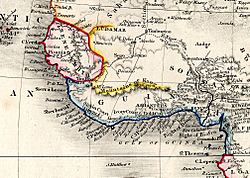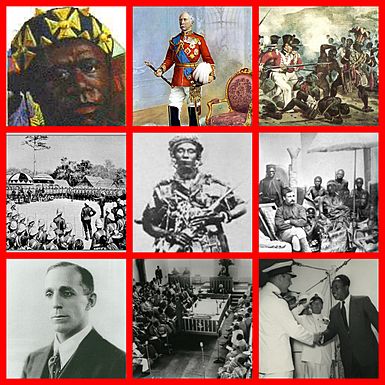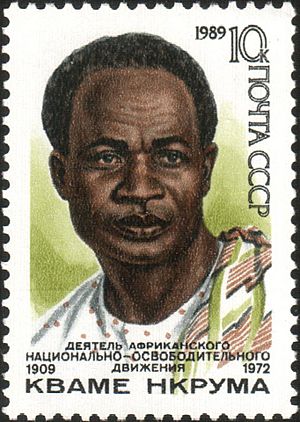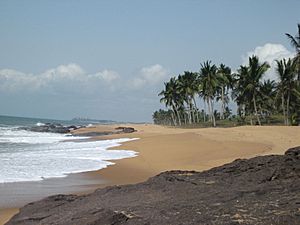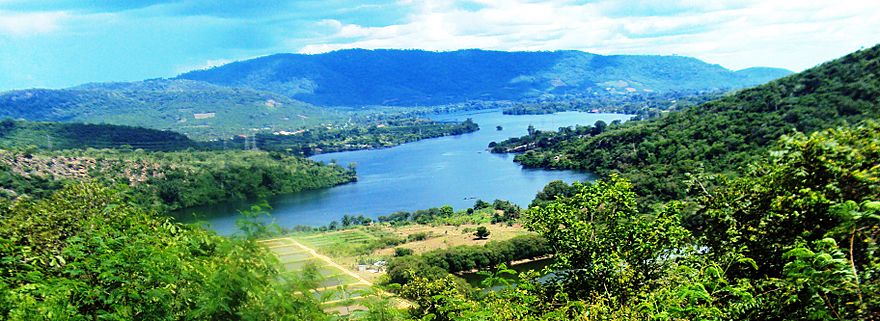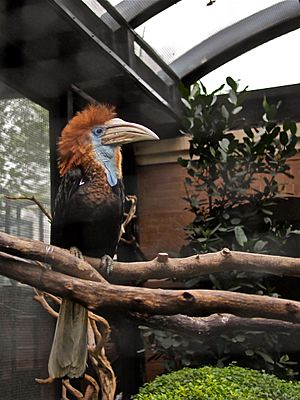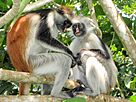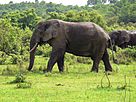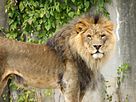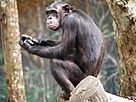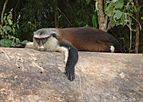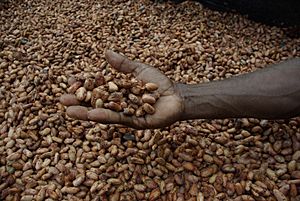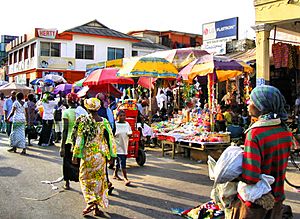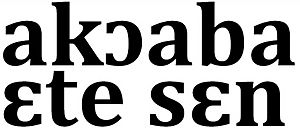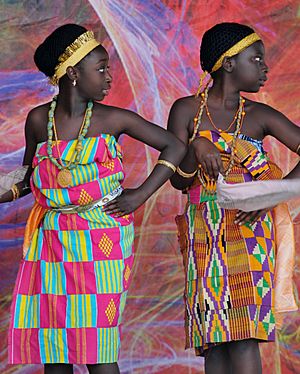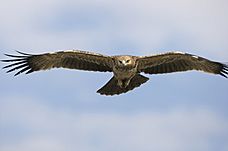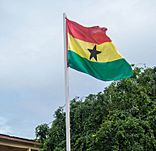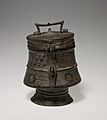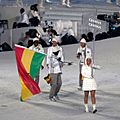Ghana facts for kids
Quick facts for kids
Republic of Ghana
|
|
|---|---|
|
Motto: "Freedom and Justice"
|
|
|
Anthem: "God Bless Our Homeland Ghana"
|
|
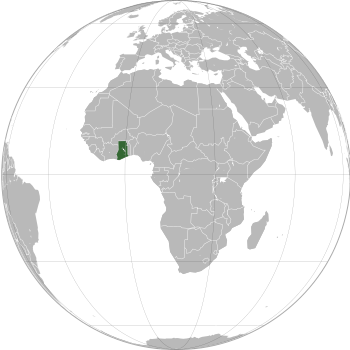 |
|
| Capital and largest city
|
Accra 05°33′18″N 00°11′33″W / 5.55500°N 0.19250°W |
| Official languages | English |
| Ethnic groups
(2021 census)
|
|
| Religion
(2021 census)
|
|
| Demonym(s) | Ghanaian |
| Government | Unitary presidential republic |
| John Mahama | |
| Jane Naana Opoku-Agyemang | |
|
• Speaker of Parliament
|
Alban Bagbin |
| Legislature | Parliament |
| Independence from the United Kingdom | |
| 6 March 1957 | |
|
• Republic
|
1 July 1960 |
| Area | |
|
• Total
|
238,540 km2 (92,100 sq mi) (80th) |
|
• Water (%)
|
4.61 (11,000 km2; 4,247 mi2) |
| Population | |
|
• 2024 estimate
|
|
|
• Census
|
30,832,019 |
|
• Density
|
151/km2 (391.1/sq mi) (90th) |
| GDP (PPP) | 2023 estimate |
|
• Total
|
|
|
• Per capita
|
|
| GDP (nominal) | 2023 estimate |
|
• Total
|
|
|
• Per capita
|
|
| Gini (2024) | medium |
| HDI (2022) | medium · 145th |
| Currency | Cedi (GHS) |
| Time zone | UTC (GMT) |
| Date format | dd/mm/yyyy |
| Driving side | right |
| Calling code | +233 |
| ISO 3166 code | GH |
| Internet TLD | .gh |
The Republic of Ghana (once known as the Gold Coast) is a country in West Africa. About 34.6 million people live there. Its capital city is Accra. Ghana is located in West Africa, next to the Gulf of Guinea, between Côte d'Ivoire and Togo.
Because Ghana is close to the Equator, it has a very warm and tropical climate. The eastern coast is warm and quite dry. The southwest is hot and humid. The northern part of Ghana is hot and dry. Lake Volta, one of the world's largest artificial lakes, stretches across eastern Ghana.
Most Ghanaians can go to primary and secondary school. Ghana has a 6-year primary school system. There are 6 public universities and 10 private universities.
Ghana has many natural resources. Its main exports include gold, timber, cocoa, and diamonds. Ghana has one of the strongest economies in Africa.
Ghana used "Cedi" as its money, but in July 2007, the "Ghana Cedi" became the new currency. One Ghana Cedi is worth 1000 old Cedi. Today, about 4 Ghana Cedi equals 1 US dollar.
Contents
History of Ghana
Ancient Times in Ghana
Archaeological finds show that people have lived in the area now called Ghana since the Bronze Age.
Medieval Kingdoms of Ghana
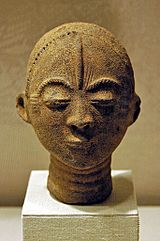
During the Middle Ages, many ancient Akan kingdoms existed in the southern and central parts of Ghana. These included the Ashanti Empire, Akwamu, Bonoman, Denkyira, and Mankessim Kingdom.
Before the 11th century, most of modern Ghana was empty land. However, the Akans had settled there by the 5th century BC. By the early 11th century, the Akans were well-established in the state of Bonoman. The Brong-Ahafo Region is named after this ancient state.
From the 13th century, Akans moved out from the Bonoman area. They created several Akan states, mainly by trading gold. These states included Ashanti, Denkyira, Mankessim Kingdom, and Akwamu. By the 19th century, the southern part of Ghana was part of the Ashanti Empire. This was one of the most powerful states in Africa before colonialism.
The Ashanti government started as a loose group of states. It later became a strong kingdom with a well-organized government. Its center was the capital city of Kumasi. Before Europeans arrived, the Ashanti people had a strong economy. It was based mainly on gold, which they traded with other African states.
The earliest known kingdoms in Ghana were the Mole-Dagbani states. The Mole-Dagombas came from what is now Burkina Faso. They were led by Naa Gbewaa. They had advanced weapons and a central leader. This allowed them to easily take over the lands of the local people. They made Gambaga their capital. After Naa Gbewaa died, his children fought a civil war. Some of them left and founded new states like Dagbon and Mamprugu.
European Arrival in Ghana (15th Century)
Akan people started trading with Europeans after the Portuguese arrived in the 15th century. The Portuguese came to the Gold Coast region to trade. They were very interested in the large amounts of gold available. The Portuguese first landed in a southern coastal city. They named it Elmina, which became the capital of the Portuguese Gold Coast.
In 1481, King John II of Portugal ordered Diogo de Azambuja to build Elmina Castle. It was finished in three years. By 1598, the Dutch people joined the Portuguese in gold trading. They set up the Dutch Gold Coast and built forts. In 1617, the Dutch took Elmina Castle from the Portuguese.
Other European traders joined in by the mid-17th century. These included the Swedish people, who created the Swedish Gold Coast. The Danish people also established the Danish Gold Coast. Portuguese merchants were so impressed by the gold that they called the area Costa do Ouro, or Gold Coast.
More than thirty forts and castles were built by the Portuguese, Swedish, Danish, Dutch, and German traders. In 1874, Great Britain took control of some parts of the country. These areas became the British Gold Coast. The British fought many battles with the Akan states and the Ashanti Empire. The Ashanti Kingdom defeated the British several times in a war that lasted 100 years. However, the Ashanti eventually lost in the War of the Golden Stool in the early 1900s.
In 1947, the new United Gold Coast Convention (UGCC) called for "self-government as soon as possible." This group included The Big Six. Kwame Nkrumah later formed the Convention People's Party (CPP). Their motto was "self-government now."
Kwame Nkrumah became the first Prime Minister of Ghana and later the first President of Ghana. He won a majority in the 1951 election for the Gold Coast Legislative Assembly. In 1952, Nkrumah was made the leader of the Gold Coast's government. The Gold Coast declared its independence from the United Kingdom on March 6, 1957. It then became the nation of Ghana.
Ghana's Independence (1957)
On March 6, 1957, at midnight, Kwame Nkrumah announced Ghana's independence. He became the first Prime Minister of Ghana. On July 1, 1960, after a public vote, Nkrumah declared Ghana a republic. He became its first President of Ghana.
The flag of Ghana was created in 1957 when the Gold Coast became Ghana. It has red, gold, green, and a black star. Theodosia Okoh designed it. The red stands for the blood shed for independence. The gold represents Ghana's mineral wealth. The green symbolizes Ghana's rich grasslands. The black star is a symbol of the Ghanaian people and African freedom.
Kwame Nkrumah was the first leader in Africa to support Pan-Africanism. This is the idea that all African people should be united. He learned about it while studying in the United States. Nkrumah combined ideas from Marcus Garvey, Martin Luther King Jr., and W. E. B. Du Bois to shape Ghana in the 1960s.
Dr. Kwame Nkrumah, as he was known, helped create the Non-Aligned Movement. This group of countries did not take sides in the Cold War. Ghanaians celebrate his achievements on his birthday, which is a public holiday called Founder's Day.
Geography of Ghana
Ghana is a country on the Gulf of Guinea. It is only a few degrees north of the Equator, which gives it a warm climate. The country covers an area of about 238,500 square kilometers (92,101 square miles). It is bordered by Togo to the east, Côte d'Ivoire to the west, Burkina Faso to the north, and the Gulf of Guinea (Atlantic Ocean) to the south.
Ghana has flat plains, low hills, and several rivers. The country can be divided into five main geographical areas. The coastline is mostly a low, sandy shore with plains and scrub behind it. Many rivers and streams cross this area. The northern part of the country has high plains. Southwest and south-central Ghana have a forested plateau region. This includes the Ashanti uplands and the Kwahu Plateau. The hilly Akuapim-Togo ranges are along Ghana's eastern border.
The Volta Basin covers most of central Ghana. Ghana's highest point is Mount Afadjato. It is 885 meters (2,904 feet) tall and is in the Akwapim-Togo Ranges.
Ghana has two main seasons: the wet season and the dry season. Northern Ghana's rainy season is from March to November. The south, including Accra, has its rainy season from April to mid-November.
Ghana's Climate
Ghana's climate is tropical. It has two main seasons: the wet season and the dry season.
Rivers and Lakes in Ghana
Ghana has a large river system with many smaller rivers flowing into it.
Wildlife in Ghana
Ghana has a wide variety of animals. Some of these animals are now protected because their numbers are decreasing. Ghana's land ecosystems have many different species. This includes 221 types of amphibians and reptiles. There are also 724 bird species and 225 mammal species. About 93 mammal species live in Ghana's savanna areas.
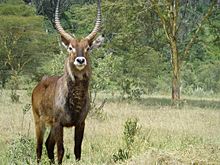
The high forest uplands in Ghana are especially rich in animal life. For example, 83% of all butterfly species found in Ghana live here. The different layers of the forest and small climate differences create many homes for specific animals.
Some animals are found only in Ghana. These include three species of frogs: Hyperolius baumanni, Hyperolius fusciventris, and Hyperolius sylvaticus. Also, the lizard Agama sylvanus is found only in Ghana's Bia Forest Reserve and Atwema Range Forest Reserve. Ghana also has many unique butterflies, with over 20 species found only there.
Ghana is home to 84 known amphibian species. These include 78 frogs, 5 toads, and caecilians. Threatened species in Ghana include four types of marine turtles and three types of crocodiles. There are also seven threatened bird species, including four found only in the Upper Guinea forest.
Important birds like hornbills, parrots, and birds of prey (like eagles) are common in Ghana. Out of 728 bird species in Ghana, 498 live there all year. Another 176 are regular seasonal migrants, with 100 coming from the Palaearctic ecozone.
Ghana is important for many vulnerable, threatened, endangered, or near-extinct mammal species. These include primates like chimpanzees and red colobus monkeys. Also, big cats like lions and leopards, and elephants live here. Ghana is on the path of major bird migration routes. There are also rare land birds, such as the Yellow-Necked Picarthes.
Ghana's Economy
Main Industries in Ghana
Ghana is rich in natural resources like minerals, oil, and precious metals. It has a growing digital economy and a mixed economy. Ghana is considered an emerging market with strong economic growth.
Ghana has an economic plan called "Ghana Vision 2020." This plan aims for Ghana to become the first developed country in Africa between 2020 and 2029. It also hopes to be a newly industrialized country between 2030 and 2039.
The Bank of Ghana started using the Chinese Yuan Renminbi in 2013. It is used alongside the national Ghana cedi for trade. This is due to Ghana's large gold reserves and economic ties with China.
The state-owned Volta River Authority and Ghana National Petroleum Corporation produce most of Ghana's electricity. The Akosombo Dam, built in 1965 on the Volta River, along with Bui Dam and Kpong Dam, provide hydropower. The Government of Ghana also plans to build a second nuclear power plant in Africa.
Ghana produces high-quality cocoa. It is the second-largest producer of cocoa in the world. It was expected to become the largest producer in 2015.
Ghana is a middle-income country. Services make up 50% of its economy. Manufacturing accounts for 24.1%, and mining (extractive industries) makes up 5%. Taxes contribute 20.9% to the economy.
Population of Ghana
In 2010, most of Ghana's 24.2 million people lived in areas historically linked to the Akan (Ashanti) territories. This included about 4.7 million in the Ashanti Region.
Also in 2010, about 4.1 million people lived in the Dagbani territories. This included 2.4 million in the Northern Region. About 2.1 million people lived in the Ewe territory, the Volta Region.
Languages Spoken in Ghana
Ghana has eleven languages that are officially supported by the government. Four are Akan languages: Asante Twi, Akuapem Twi, Mfantse, and Nzema. Two are Mole-Dagbani languages: Dagaare and Dagbanli. The other languages are Ewe, Dangme, Ga, Gonja, and Kasem.
English is the official language of the state. It is widely used for communication across different language groups.
Culture of Ghana
Ghanaian culture is a rich mix of practices and beliefs from all its different Ghanaian people groups.
Food and Drink in Ghana
Ghanaian cuisine is very varied. It includes many soups and stews made with different kinds of seafood. Most Ghanaian soups are prepared with vegetables, meat, poultry, or fish. Fish is an important part of the Ghanaian diet. Tilapia, roasted and fried whitebait, smoked fish, and crayfish are common in Ghanaian dishes.
Banku is a common Ghanaian starchy food made from ground corn. Cornmeal-based foods like dokonu (kenkey) and banku are often eaten with fried fish (chinam) or grilled tilapia. They are usually served with a very spicy sauce made from red and green chillies, onions, and tomatoes. Banku and tilapia is a popular meal in most Ghanaian restaurants. Fufu is a Ghanaian dish that is well-known around the world.
Traditional Clothing in Ghana
Ghanaians use many different fabrics for their traditional clothes, besides the Adinkra cloth. Each ethnic group has its own special cloth. The most famous is the Kente cloth. Kente is a very important Ghanaian national costume. These cloths are used to make both traditional and modern Ghanaian Kente clothes.
Different symbols and colors in Kente cloth have different meanings. Kente is the most famous Ghanaian cloth. It is a ceremonial cloth hand-woven on a special loom. Strips about 4 inches wide are sewn together to make larger pieces. Kente cloths come in many colors, sizes, and designs. They are worn during important social and religious events.
Kente is more than just a cloth; it tells stories of history. It is also a form of written language through weaving. The word "kente" comes from the Akan word kɛntɛn, meaning "a basket." The first kente weavers used raffia fibers to weave cloths that looked like baskets. So, they were called kenten ntoma, meaning "basket cloth." The original Akan name was nsaduaso or nwontoma, meaning "a cloth hand-woven on a loom." However, "kente" is the most common name today.
Music and Dance in Ghana
The music of Ghana is very diverse, changing between different ethnic groups and regions. Ghanaian music uses several unique instruments. These include talking drum groups, Akan Drums, the goje fiddle, and the koloko lute. Court music includes the Akan Seperewa and the Akan atumpan. The Ga kpanlogo styles and log xylophones are used in asonko music.
The most famous music genres from Ghana are African jazz, created by Kofi Ghanaba, and highlife. Highlife started in the late 19th and early 20th centuries and spread across West Africa. In the 1990s, young people created a new music style called Hiplife. It mixed highlife, Afro-reggae, dancehall, and hiphop. Ghanaian artists like R&B singer Rhian Benson and rapper Sarkodie have become famous internationally.
Ghanaian dance is as varied as its music. There are traditional dances and different dances for different events. The most well-known Ghanaian dances are for celebrations. Some of these dances include Adowa, Kpanlogo, Azonto, Klama, and Bamaya.
National Symbols of Ghana
The coat of arms shows two animals: the tawny eagle (a large bird living in savannas and deserts) and the lion (a big cat). It also features a ceremonial sword, a castle on a sea, a cocoa tree, and a mine shaft. These represent Ghana's mineral wealth. A five-pointed black star with a gold rim stands for Ghana's gold and the guiding star of the Ghanaian people. The motto "Freedom and Justice" is also on the coat of arms.
The flag of Ghana has three horizontal bands (strips) of red (top), gold (middle), and green (bottom). All three bands are the same height and width. The middle gold band has a five-pointed black star in its center. The red band stands for the blood shed to gain independence. The gold represents Ghana's mineral wealth. The green symbolizes Ghana's rich tropical rainforests and natural resources.
Tourism in Ghana
In 2011, 1,087,000 tourists visited Ghana. Tourists come from South America, Asia, Europe, and North America. Ghana's warm tropical climate all year round is a big draw.
Ghana has many wildlife areas and beautiful waterfalls, like Kintampo Waterfalls and Tagbo Falls (the largest in West Africa). Its coastal sandy beaches are lined with palm trees. There are also caves, mountains, rivers, and lakes like Lake Bosumtwi. Lake Volta is the largest lake in the world by surface area.
Ghana also has dozens of castles and forts, many of which are UNESCO World Heritage Sites. There are also many nature reserves and national parks.
In 2010, the World Economic Forum ranked Ghana 108th out of 139 countries for tourism. In 2011, Forbes magazine said Ghana was the eleventh most friendly country in the world. This was based on a survey of travelers in 2010. Among African countries, Ghana ranked highest. Tourism is the fourth biggest earner of foreign money for Ghana. In 2014, Ghana was ranked the 61st–most peaceful country in the world.
To visit Ghana, you need a visa from the Government of Ghana. Travelers must apply for this visa at a Ghanaian embassy, which usually takes about two weeks. The visa is typically valid for up to 60 days. Visitors must also show a yellow fever vaccination certificate.
Notable People from Ghana
Related Pages
Images for kids
-
The Portuguese built Elmina Castle in 1482. It is the oldest European building in sub-Saharan Africa.
-
During the Anglo-Ashanti wars, British troops searched a chief's palace in Fomena in 1874, on their way to Kumasi.
-
Kwame Nkrumah, the first President of Ghana.
-
Traditional chiefs in Ghana in 2015.
-
Surfers enjoying the waves at Busua Beach in the Western region.
-
A beautiful villa in East Ridge.
-
Ghana's education system uses information and communications technology at the University of Ghana.
-
The Ghana Card (Ghanaian electronic ID Card) with its chip.
-
The Black Stars, which is the Ghana national football team.
-
Ghana's winter sports Olympic team at the opening ceremony of the 2010 Winter Olympics.
-
Modern high-rise buildings in Accra, the capital city.
See also
 In Spanish: Ghana para niños
In Spanish: Ghana para niños




